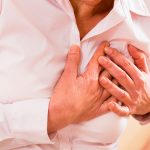Hot flashes and night sweats are categorized as vasomotor symptoms during menopause. The mechanisms that produce hot flashes during the day are the same as the mechanisms that produce hot flashes and night sweats at night. At night, they more typically turn into sweats due to some differences in hormones produced during the day versus hormones produced during the night. Night sweats tend to also be aggravated by something as simple as just covering up with sheets.
Ultimately, hot flashes and night sweats are due to a decline in estrogen, which secondarily affects certain neurotransmitters in the brain called serotonin and norepinephrine. These neurotransmitters are critical for the thermal regulatory centers of the entire body. With a narrowing of the thermal regulatory set point, the body is more likely to be sensitive to environmental changes in temperature and cause hot flashes. They can occur as superficial vasodilation and redness that occurs on the chest, neck, and face. They may also occur peripherally in the arms and the legs. As tiny blood vessels under the skin become more dilated more blood flows through those blood vessels.
The good news is there are a lot of potential strategies to address hot flashes and night sweats. The first strategy is to avoid triggers. Simple things like staying in a cool room and having a circulating fan going can be helpful. Sometimes exercise can trigger a menopausal hot flash or night sweats. Certainly anxiety, stress, panic, and nervousness can trigger hot flashes and night sweats. At night, insomnia can trigger a hot flash, which can trigger night sweats, which can trigger insomnia, and so on. Dressing in loose clothing and having loose bedding on your bed can help prevent night sweats as well.
Dietarily speaking, proper hydration is very important. Caffeine can trigger night sweats and hot flashes. Chocolate, spicy foods, refined sugars and desserts can all trigger hot flashes and night sweats, so be cautious about those desserts after dinnertime.
Therapeutically, many things that can be beneficial. Consider deep breathing exercises, meditation, hypnosis, yoga, or acupuncture. For some women, mild to moderate exercise is helpful for minimizing, reducing severity, and frequency of hot flashes. Eating a diet rich in phytoestrogens can be helpful for hot flashes. Omega 3 fatty acids and Vitamin E found in flax seeds, chia seeds, and hemp seeds can be helpful for hot flashes.
There are also specific botanical agents that can be useful for hot flashes. The phytoestrogens found in red clover, gingko, ginseng, hops, licorice, thyme, alfalfa, soy, kudzu and dong quai can be effective. Rice bran oil has also been beneficial in studies to reduce both the severity and frequency of hot flashes.
Evening primrose oil (EPO) contains high amounts of an essential Omega 6 fatty acid called GLA, Gama Linolenic Acid. We know that GLA can have some significant impacts on improving inflammatory cytokine levels and the pro-inflammatory chemicals produced in the body actually can be decreased by taking GLA.
EPO is utilized mostly for three conditions. 1) Skin inflammatory conditions like eczema and acne, 2) breast pain, and 3) menopause. EPO has a number of studies for treating cyclical mastalgia or cyclical breast pain effectively.
Regarding menopause, I think of EPO for two therapeutic purposes. Firstly, for hot flashes. In a recent study, compared to placebo, EPO decreased the severity of hot flashes. It did not cut down on the frequency of hot flashes, but when those women studied did report hot flashes, they were less severe while taking evening primrose oil compared to placebo.
I also like EPO for improving risk factors for breast cancer. There have been some studies that show that, in petri dishes, when breast cancer cells are treated with GLA and evening primrose oil, those breast cancer cells become less aggressive and less invasive. I think in terms of promoting healthy breast tissue perimenopausally and postmenopausally, evening primrose oil has a real role to play.
Flax Seed
The whole flax seed, flax seed flour, and flax seed meal have all been used in perimenopause/menopause for the positive effects of the lignans, a unique type of fiber for flax. The lignans are known to influence the metabolism of estrogen in fantastic ways. Lignans cause the 2-Hydroxy estrogen metabolite to increase and the 16-hydroxy metabolite to decrease. This sets up a favorable metabolic state for reducing risk factors for breast cancer, metabolic syndrome, osteoporosis, and a number of other health issues that can occur postmenopausally.
In addition, flax has been studied and shown to be beneficial for treating not only the menopausal symptoms like hot flashes and mood disorders during menopause, but also for helping to decrease pro-inflammatory chemicals and cytokines that are known to elevate risk factors for osteoporosis, dementia, breast cancer, a number of postmenopausal conditions that can significantly impact your life.
Black cohosh
Black cohosh affects serotonin levels in the brain AND it contains phytoestrogens. If we look at black cohosh and simply look at its effectiveness on hot flashes, night sweats, depression and anxiety, it turns out it can be rather effective during perimenopause and menopause. Oftentimes in large scientific studies, researchers use menopausal scales that go through a number of different symptoms. If the participant’s overall score goes lower, the therapy is considered to be ineffective. However, if you parcel out and dissect just those symptoms that you would actually expect to improve when you improve neurotransmitter serotonin levels such as vasomotor symptoms, hot flashes, night sweats, depression and anxiety, black cohosh actually does seem to be effective. That’s likely why it’s the most popular botanical extract used in the United States for perimenopausal and menopausal symptoms.











